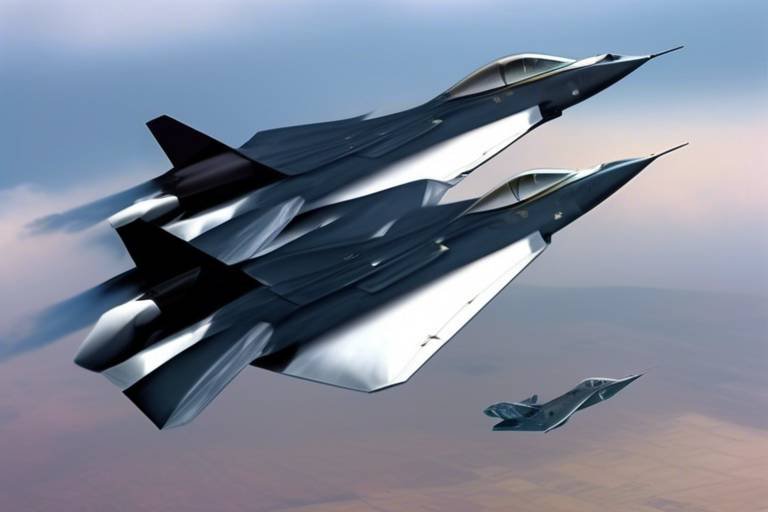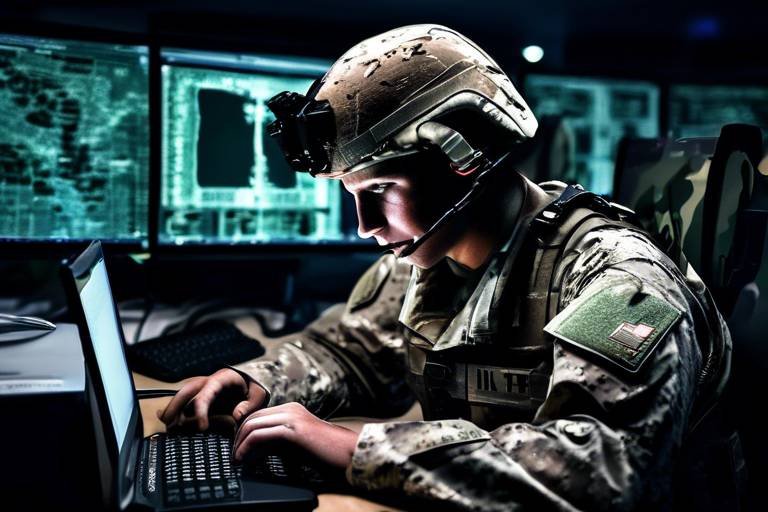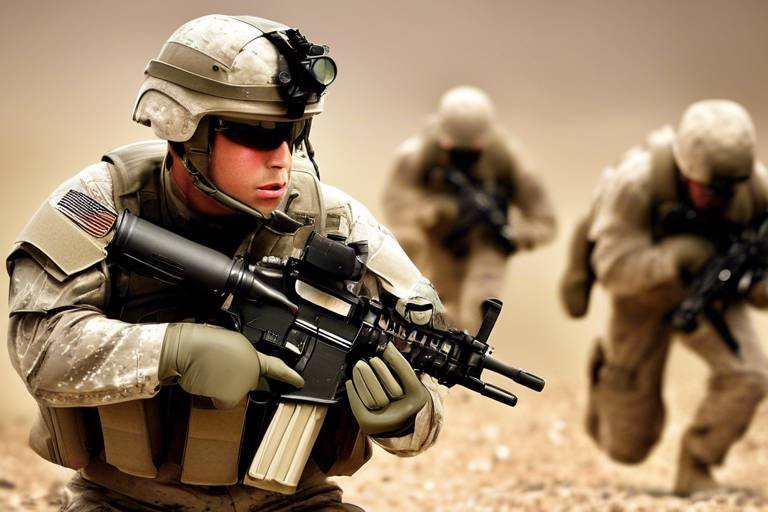Developing Stealth Technologies for Modern Combat Aircraft
In the fast-paced world of military aviation, the development of stealth technologies has become a game-changer for modern combat aircraft. As threats evolve, so too must the tools and tactics employed by air forces around the globe. Stealth technology not only enhances the survivability of aircraft but also provides strategic advantages in terms of reconnaissance, strike capabilities, and overall mission success. Imagine flying a jet that can evade enemy radar systems, glide through hostile airspace undetected, and engage targets with precision. This is the reality that cutting-edge stealth technology aims to achieve.
The journey of stealth technology began decades ago, and it has undergone significant transformations to meet the demands of contemporary warfare. Initially, stealth was a concept that seemed almost futuristic, but today, it is a fundamental component in the design and operation of modern military aircraft. From the iconic F-117 Nighthawk to the latest fifth-generation fighters like the F-35 Lightning II, the evolution of stealth technology has been marked by innovative designs, advanced materials, and a deep understanding of physics.
At its core, stealth technology revolves around minimizing an aircraft's radar signature and other forms of detection. This involves a combination of geometric design features, material innovations, and sophisticated electronic warfare systems. The goal is to create an aircraft that can operate in contested environments without being easily detected or targeted. As we delve deeper into the principles and challenges of stealth technology, we will uncover the intricacies that make modern combat aircraft not just machines of war, but marvels of engineering.
As we explore this fascinating topic, we will also look at the future trends that are shaping the next generation of stealth capabilities. With advancements in artificial intelligence and the integration of unmanned systems, the battlefield of tomorrow will be vastly different from today. The ongoing quest for air superiority will demand continuous innovation, and understanding the current landscape of stealth technology is crucial for appreciating what lies ahead.
- What is stealth technology? Stealth technology refers to methods used to make aircraft less detectable by radar, infrared, and other detection systems.
- How does stealth technology work? It works by employing specific designs and materials that reduce radar cross-section and infrared signatures, making aircraft harder to detect.
- Why is stealth technology important? It provides a tactical advantage by allowing aircraft to operate in hostile environments without being easily targeted.
- What are the challenges in developing stealth technology? Challenges include balancing performance and cost, addressing technological limitations, and adapting to evolving threats.
- What is the future of stealth technology? The future involves integrating advanced systems, artificial intelligence, and unmanned vehicles to enhance operational capabilities.

Evolution of Stealth Technology
The journey of stealth technology is as fascinating as it is complex, rooted in the need for military superiority and the protection of personnel and assets. It all began during the Cold War, a period characterized by intense rivalry and a race for technological advancements. The initial concept of stealth was born out of a desire to evade radar detection, leading to the development of aircraft that could operate undetected in hostile environments. The first notable example was the Lockheed U-2, which took to the skies in the 1950s. Its sleek design and high altitude capabilities allowed it to gather intelligence without being easily spotted by enemy radar.
As technology progressed, so did the methods of detection. The introduction of more advanced radar systems during the 1970s and 80s necessitated a shift in design philosophy. The F-117 Nighthawk, unveiled in the 1980s, showcased groundbreaking innovations in shaping and materials that minimized radar cross-section. This aircraft was not just a leap forward in design; it was a bold statement that stealth could redefine air combat. The Nighthawk's success in the Gulf War proved that stealth was not merely a theoretical concept but a practical reality that could alter the dynamics of warfare.
Fast forward to today, and stealth technology has evolved significantly. Modern combat aircraft like the F-22 Raptor and F-35 Lightning II incorporate advanced materials and sophisticated design features that enhance their stealth capabilities. These aircraft utilize radar-absorbent materials (RAM) and are shaped to deflect radar waves, making them nearly invisible to enemy detection systems. The evolution of stealth technology is not just about aircraft design; it also encompasses the integration of sensor fusion and network-centric warfare strategies, enabling pilots to operate in a more informed and tactical manner.
However, the evolution of stealth technology is not without its challenges. As detection systems become more sophisticated, the arms race between stealth capabilities and radar technology continues. This ongoing struggle has led to a cycle of innovation, where each advancement in stealth prompts a corresponding leap in detection technology. The future of stealth technology will likely involve a combination of traditional stealth techniques and cutting-edge innovations, such as the incorporation of artificial intelligence and unmanned systems, to maintain air superiority.
In summary, the evolution of stealth technology reflects a dynamic interplay between the need for secrecy in military operations and the relentless advancement of detection systems. As we look to the future, the lessons learned from past developments will undoubtedly shape the next generation of combat aircraft, ensuring that stealth remains a critical component of modern military strategy.
- What is stealth technology? Stealth technology refers to methods and materials used to make aircraft less detectable by radar and other tracking systems.
- When was the first stealth aircraft developed? The first notable stealth aircraft was the Lockheed U-2, developed in the 1950s.
- How does stealth technology work? Stealth technology works by reducing the radar cross-section of an aircraft and using materials that absorb radar waves, along with specific geometric designs that deflect radar signals.
- What are some modern stealth aircraft? Modern stealth aircraft include the F-22 Raptor, F-35 Lightning II, and the B-2 Spirit bomber.
- What challenges does stealth technology face? Stealth technology faces challenges from advancements in radar technology, cost implications, and the need for ongoing research and development.

Key Principles of Stealth Design
When it comes to the realm of modern combat aircraft, the term stealth isn't just a buzzword—it's a game-changer. The are rooted in a combination of advanced engineering, innovative materials, and strategic design choices that work together to minimize an aircraft's detectability. Understanding these principles is essential for grasping how today’s fighters maintain an edge in the skies.
At the heart of stealth design lies the concept of radar-absorbent materials (RAM). These materials are specially formulated to absorb radar waves rather than reflect them, effectively reducing the aircraft's radar cross-section (RCS). By utilizing RAM, engineers can ensure that enemy radar systems struggle to pinpoint the location of a stealth aircraft, much like how a ninja blends into the shadows. This leads us to the next principle—shape optimization.
Shape optimization involves creating an aircraft's exterior to deflect radar waves away from their source. Think of it as a well-angled mirror that redirects light instead of reflecting it back. Stealth aircraft often feature angular designs, sharp edges, and flat surfaces that scatter radar waves, making it difficult for enemy systems to track them. The combination of RAM and optimized shapes results in a significant reduction in RCS, allowing these aircraft to operate with a level of survivability that traditional fighters cannot match.
Reducing an aircraft's radar cross section (RCS) is a critical aspect of stealth technology. The lower the RCS, the harder it is for enemy radar systems to detect and track the aircraft. This reduction is achieved through a combination of geometric design features and material innovations. For instance, the use of curved surfaces can help deflect radar waves, while the careful placement of internal components minimizes radar reflections.
The geometric design of stealth aircraft is meticulously crafted to achieve optimal radar deflection. This involves a range of design elements, including:
- Flat surfaces: These help in scattering radar waves rather than reflecting them directly back to the source.
- Angular shapes: Sharp angles can redirect radar waves away from the radar source.
- Internal component placement: Positioning engines and other components inside the airframe reduces radar reflection.
Innovative materials play a crucial role in enhancing stealth capabilities. Radar-absorbent coatings are applied to the aircraft's surface to further reduce radar signatures. These coatings can be tailored to different frequency ranges, ensuring that they effectively absorb radar waves across various detection systems. Additionally, advancements in composite materials have led to lighter, stronger airframes that are easier to maneuver while maintaining stealth characteristics.
Stealth isn't just about evading radar; it also involves managing infrared signatures. Modern combat aircraft generate heat from their engines and systems, which can be detected by heat-seeking missiles and infrared tracking systems. To combat this, engineers employ various techniques to minimize heat emissions. This includes the use of heat shields and the strategic placement of exhaust systems to disperse heat more effectively. By keeping their infrared signatures low, stealth aircraft can operate with greater freedom and safety in hostile environments.
In summary, the revolve around the integration of advanced materials, geometric design features, and infrared management techniques. These elements work synergistically to create aircraft that are not only difficult to detect but also capable of executing missions with a high degree of operational effectiveness. As technology continues to evolve, we can expect these principles to adapt, leading to even more sophisticated stealth capabilities in the future.
- What is stealth technology? Stealth technology refers to methods used in aircraft design to make them less detectable by radar and other detection systems.
- How do radar-absorbent materials work? These materials absorb radar waves instead of reflecting them, significantly reducing the radar cross-section of the aircraft.
- Why is infrared signature management important? Managing infrared signatures is crucial to avoid detection by heat-seeking missiles and infrared tracking systems.
- What are some challenges in developing stealth technology? Challenges include balancing cost and performance, addressing technological limitations, and adapting to evolving military tactics.
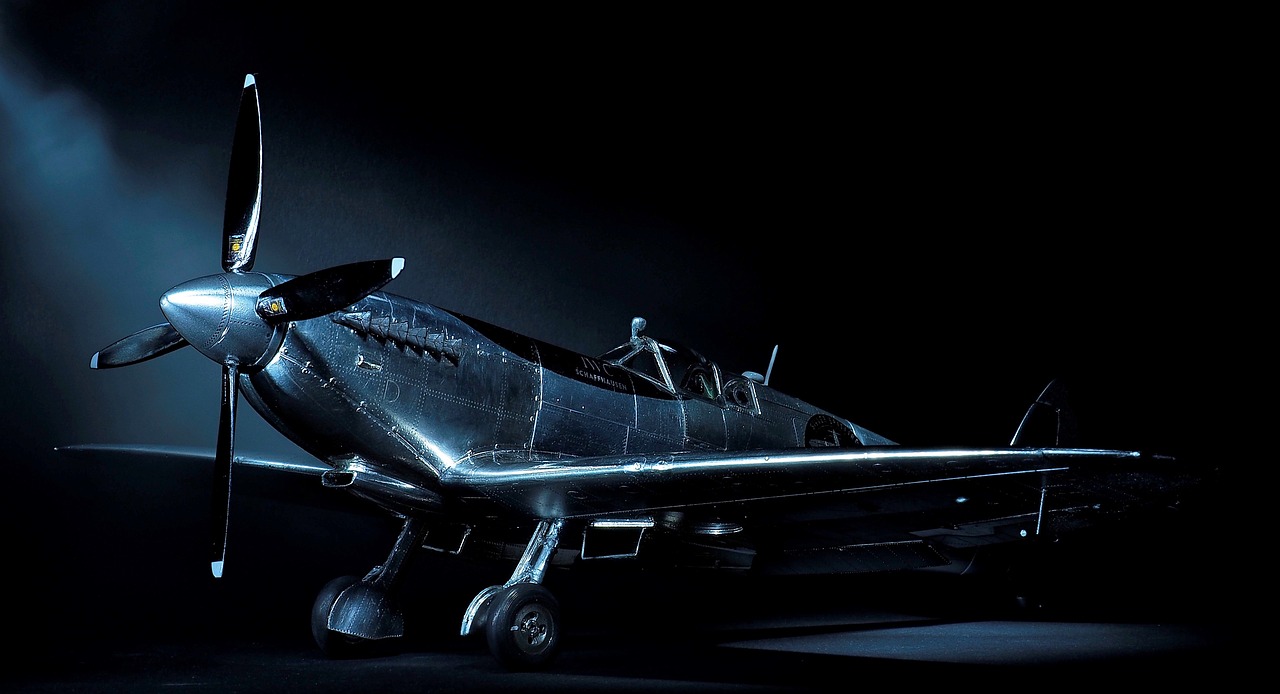
Radar Cross Section Reduction
When it comes to stealth technology, one of the most critical elements is radar cross section (RCS) reduction. This term refers to the measure of how detectable an object is by radar systems, and in the world of modern combat aircraft, a smaller RCS means a significantly lower chance of being spotted by enemy radar. Imagine trying to find a needle in a haystack; that's what radar operators face when tracking stealth aircraft designed with RCS reduction in mind. The goal is to make these aircraft as elusive as possible, allowing them to operate in hostile environments with a greater degree of safety.
To achieve effective RCS reduction, engineers and designers employ a variety of strategies that can be broadly categorized into three main approaches: geometric design features, material innovations, and active cancellation techniques. Each of these plays a vital role in minimizing an aircraft's radar signature and enhancing its survivability during missions.
Firstly, let's explore the geometric design features. The shape of a stealth aircraft is meticulously crafted to deflect radar waves away from the source. This involves using angled surfaces and flat panels that scatter radar signals instead of reflecting them directly back to the radar source. For example, the famed B-2 Spirit bomber employs a flying wing design that not only enhances aerodynamic efficiency but also significantly reduces its RCS. The F-22 Raptor and F-35 Lightning II also utilize advanced geometric configurations to achieve similar stealth capabilities.
Next, we have material innovations. The development of radar-absorbent materials (RAM) has been a game changer in the quest for stealth. These materials are designed to absorb radar waves rather than reflecting them, effectively reducing the RCS of an aircraft. They can be applied as coatings or integrated into the structure of the aircraft itself. For instance, the F-35 features a unique blend of composites and RAM that allows it to maintain a low signature while ensuring structural integrity. The continuous research into new materials promises even greater advancements in RCS reduction in the future.
Moreover, active cancellation techniques are emerging as a sophisticated method of RCS reduction. These systems work by emitting signals that counteract the radar waves, effectively 'cancelling out' the radar signature of the aircraft. This technology is still in its infancy but holds immense potential for the future of stealth operations.
In summary, radar cross section reduction is a multi-faceted approach that combines innovative design, advanced materials, and cutting-edge technology. As military aviation continues to evolve, the importance of RCS reduction cannot be overstated. It not only enhances the survivability of aircraft in combat but also allows for greater tactical flexibility on the battlefield. The ongoing advancements in this field will undoubtedly shape the future of aerial warfare and redefine how nations approach their defense strategies.
- What is radar cross section (RCS)?
RCS is a measure of how detectable an object is by radar systems; a smaller RCS indicates a lower chance of detection. - How do geometric design features help in RCS reduction?
They are designed to deflect radar waves away from the source, minimizing the radar signature of the aircraft. - What are radar-absorbent materials (RAM)?
RAM are specialized materials that absorb radar waves rather than reflecting them, reducing the aircraft's radar visibility. - Are active cancellation techniques effective?
While still developing, active cancellation techniques show promise in further reducing RCS by counteracting radar signals.
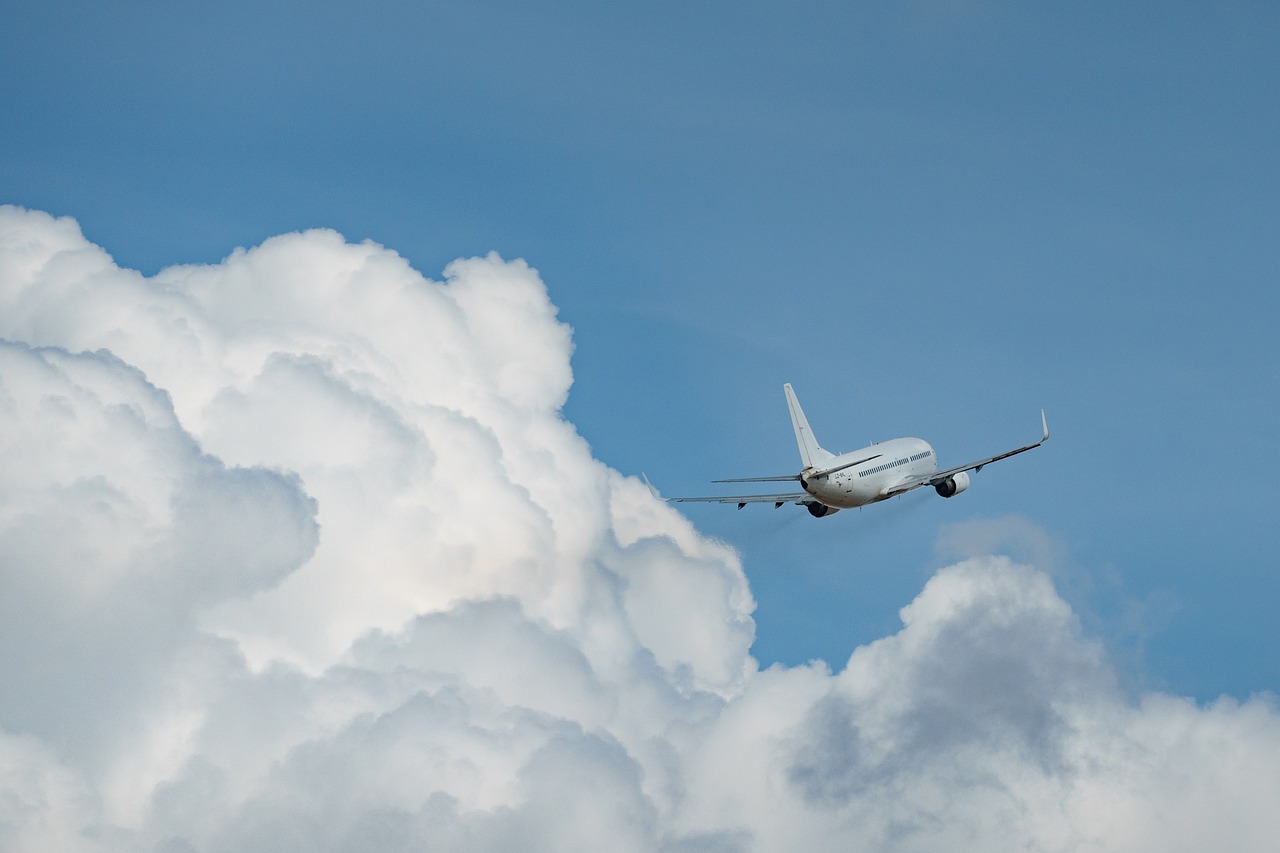
Geometric Design Features
The geometric design of stealth aircraft is a fascinating blend of art and science, meticulously crafted to achieve one primary goal: minimizing radar detection. Think of it like a well-angled mirror that reflects light away rather than back at you. In the same way, stealth aircraft utilize specific shapes and contours to deflect radar waves, ensuring they remain undetected by enemy radar systems. This involves not just the overall silhouette but also the intricate details of the aircraft's surface and structure.
One critical aspect of geometric design is the shape optimization of the aircraft. Stealth fighters often feature flat surfaces and sharp angles, which are strategically placed to scatter radar waves rather than allowing them to bounce back directly to the source. For instance, the iconic triangular shape of the F-117 Nighthawk is not just for aesthetics; it’s a fundamental design choice that enhances its stealth capabilities. The aircraft's edges are designed to create a low radar cross-section, which is essential for evading detection.
Moreover, the wing design plays a significant role in stealth technology. Many modern stealth aircraft employ a blended wing-body configuration, which integrates the wings and fuselage into a single, smooth shape. This design not only aids in aerodynamic efficiency but also helps in reducing the radar signature. By eliminating protruding parts and minimizing the number of surfaces that can reflect radar waves, these aircraft can fly under the radar—literally!
In addition to the overall shape, the control surfaces of the aircraft, such as flaps and ailerons, are designed to retract or blend into the body of the aircraft when not in use. This feature minimizes the radar reflections that could give away the aircraft's position. Furthermore, the use of stealthy exhaust designs ensures that the heat generated by the engines is dispersed in a way that makes it difficult for infrared sensors to detect. The combination of these geometric features creates a formidable barrier against enemy detection systems.
To illustrate the impact of these design features, let’s take a look at a comparison of traditional aircraft versus stealth aircraft in terms of radar cross-section:
| Aircraft Type | Radar Cross Section (m²) |
|---|---|
| Conventional Fighter Jet | 10-50 |
| Stealth Fighter (e.g., F-22) | 0.001-0.1 |
This table highlights the dramatic difference in radar visibility between traditional and stealth aircraft, showcasing the effectiveness of geometric design in achieving stealth capabilities. As technology continues to evolve, we can expect even more innovative geometric designs that further enhance the stealth features of future combat aircraft.
- What is the primary goal of geometric design in stealth aircraft?
The primary goal is to minimize radar detection by deflecting radar waves away from the enemy radar systems. - How does the shape of an aircraft affect its radar visibility?
Aircraft shapes that are flat and angular help scatter radar waves, resulting in a lower radar cross-section. - What role do control surfaces play in stealth technology?
Control surfaces are designed to retract or blend into the aircraft's body when not in use to reduce radar reflections. - Can the design of stealth aircraft change in the future?
Absolutely! As technology advances, we can expect new designs that enhance stealth capabilities even further.
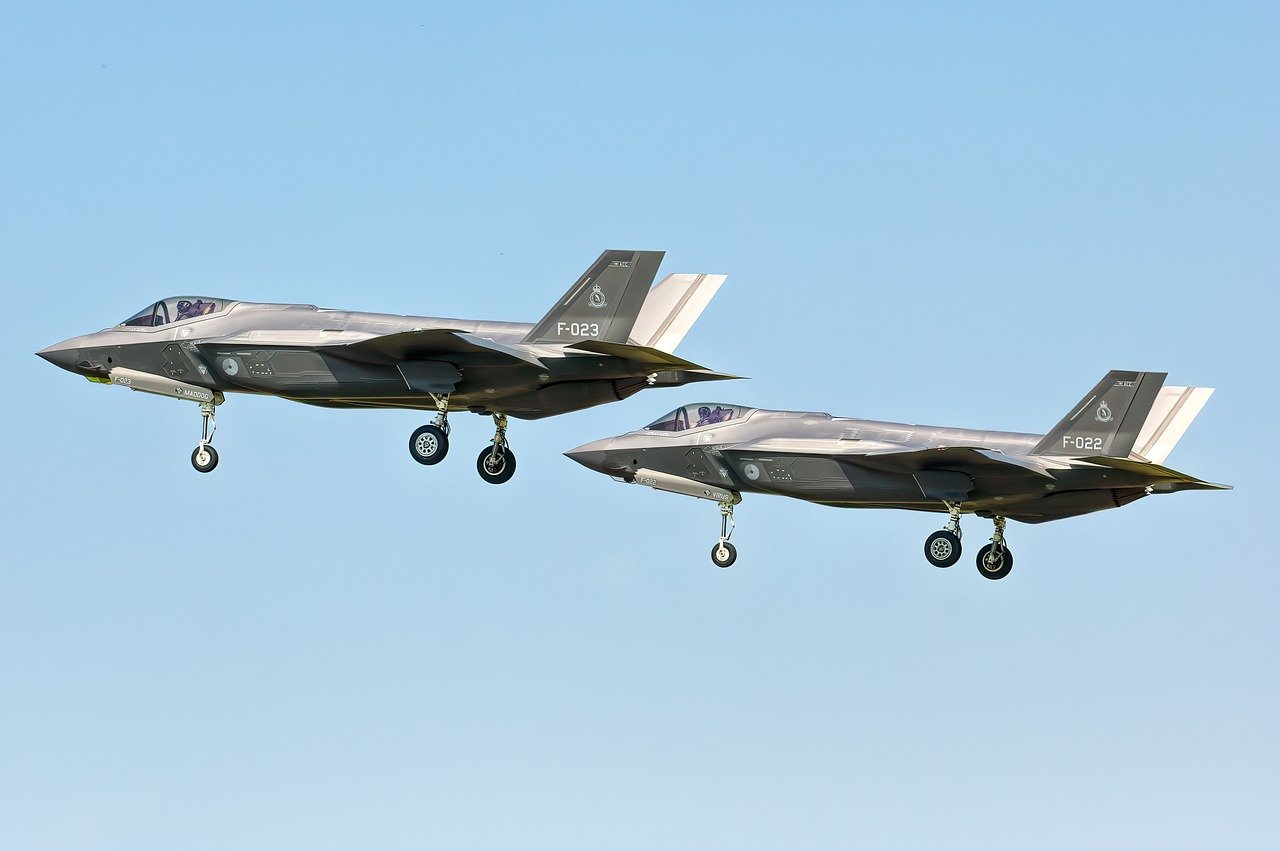
Material Innovations
In the realm of stealth technology, are nothing short of revolutionary. These advancements not only enhance the performance of combat aircraft but also redefine the very essence of aerial warfare. Imagine flying a jet that can evade radar detection with the same finesse as a shadow slipping through the night. This is the reality that modern materials are helping to create.
One of the most significant breakthroughs in stealth technology is the development of radar-absorbent materials (RAM). These specialized coatings are designed to absorb radar waves rather than reflect them, significantly reducing an aircraft's radar cross-section. Think of it like wearing a suit that makes you invisible to the eyes of a hawk. The effectiveness of RAM is crucial, as it allows aircraft to operate in hostile environments with a lower risk of detection.
Moreover, the integration of composite materials into aircraft design is a game-changer. Composites are lighter and stronger than traditional materials, allowing for enhanced maneuverability and fuel efficiency. This not only improves the aircraft's overall performance but also contributes to its stealth capabilities. By utilizing materials that are both lightweight and radar-absorbent, manufacturers can craft aircraft that fly faster and farther while remaining undetectable.
Additionally, thermal management materials play a vital role in reducing infrared signatures. These materials help to dissipate heat generated by engines and other systems, making it more challenging for heat-seeking missiles to lock onto the aircraft. Picture a car driving through a desert; if it radiates heat, it becomes an easy target for predators. However, with advanced thermal management, it can blend into the environment, evading detection.
Furthermore, the future of stealth technology is leaning towards smart materials. These are materials that can adapt to their environment or operational conditions. For instance, imagine an aircraft that can change its surface properties to become more radar-absorbent when it enters enemy airspace. This adaptability could revolutionize the way stealth is approached in military aviation.
In summary, the ongoing innovations in materials used for stealth technologies are crucial in enhancing the capabilities of modern combat aircraft. As we look to the future, the potential for new materials to further minimize detection and improve performance is boundless. The battlefield of tomorrow will undoubtedly be shaped by these advancements, making air superiority not just a goal, but a reality.
- What are radar-absorbent materials? Radar-absorbent materials are specialized coatings that absorb radar waves to reduce an aircraft's radar cross-section, making it less detectable by enemy radar systems.
- How do composite materials contribute to stealth? Composite materials are lighter and stronger than traditional materials, improving aircraft performance and contributing to stealth by allowing for radar-absorbent designs.
- What role do thermal management materials play in stealth technology? Thermal management materials help dissipate heat from aircraft systems, reducing infrared signatures and making it harder for heat-seeking missiles to detect them.
- What are smart materials in the context of stealth technology? Smart materials can adapt their properties based on environmental conditions, potentially enhancing stealth capabilities by changing surface characteristics when needed.
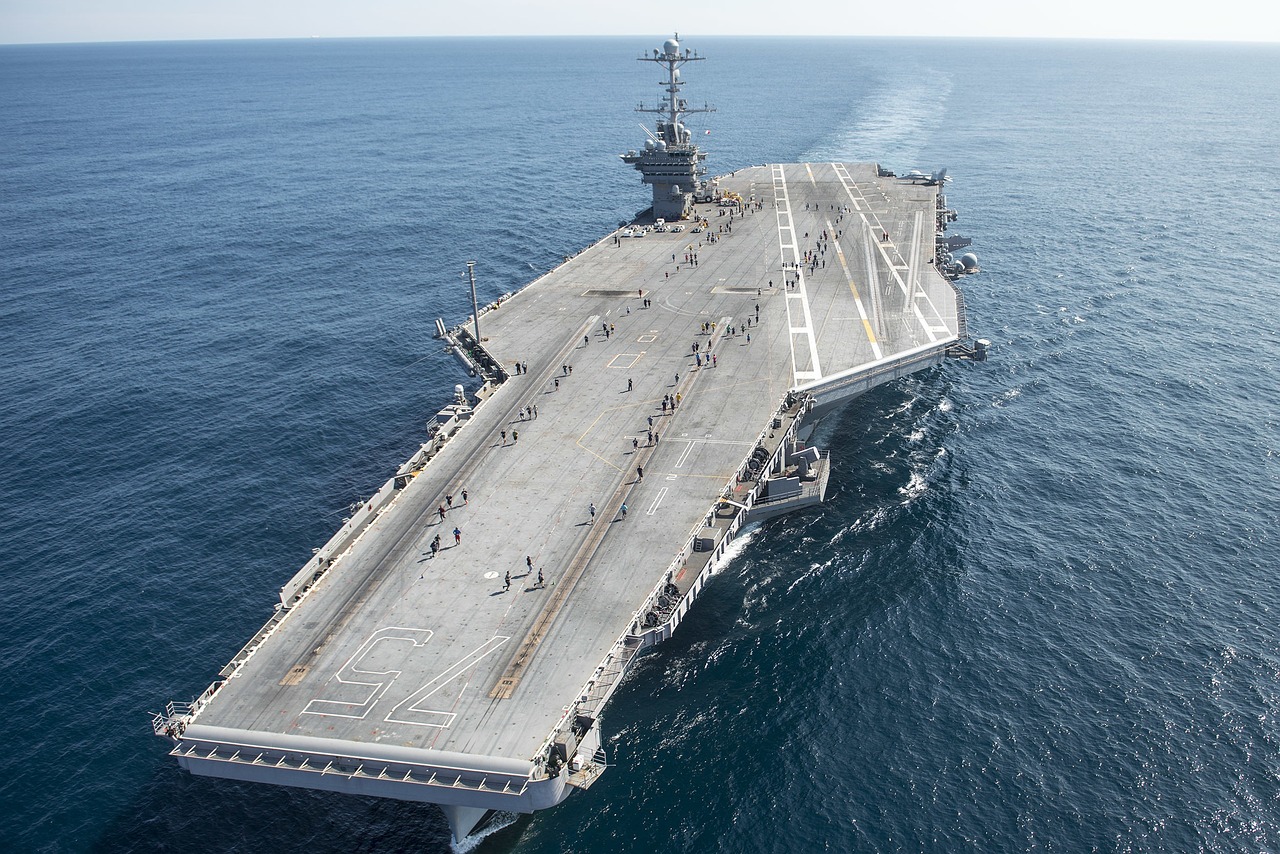
Infrared Signature Management
When we talk about stealth in modern combat aircraft, one of the most fascinating aspects is . This technology is crucial because it helps reduce the heat emissions of an aircraft, making it less visible to heat-seeking missiles and infrared tracking systems. Imagine trying to hide a bright light in a dark room; the brighter the light, the easier it is to spot. In the same way, an aircraft that emits high levels of heat becomes an easy target for enemy defenses. Therefore, managing this signature is not just a technical requirement; it’s a matter of life and death on the battlefield.
At its core, infrared signature management involves a combination of design choices and technological innovations. For instance, the engine exhaust can be cooled before it exits the aircraft, significantly reducing the thermal signature. Additionally, using heat-resistant materials and advanced coatings can further minimize heat emissions. These efforts can be likened to wearing a thermal blanket on a cold night; it keeps the warmth in while preventing heat from escaping into the environment.
Moreover, the positioning of engine intakes and exhausts plays a pivotal role in managing infrared signatures. By carefully designing these components, engineers can ensure that hot air is directed away from enemy sensors. This design philosophy is akin to how a stealthy animal moves through its environment, using the terrain to hide its presence.
To give you a clearer picture, here’s a brief overview of the key strategies employed in infrared signature management:
| Strategy | Description |
|---|---|
| Engine Exhaust Cooling | Cooling the exhaust gases before they exit the aircraft to reduce thermal signature. |
| Heat-Resistant Materials | Using specialized materials that absorb and dissipate heat effectively. |
| Design Optimization | Positioning engine components to minimize exposure to enemy sensors. |
In addition to physical modifications, active countermeasures are also being developed. These systems can actively disrupt infrared tracking systems, adding another layer of defense. Think of it like wearing camouflage that not only blends in but also confuses your pursuers. As technology progresses, we can expect to see even more sophisticated methods being employed to manage infrared signatures effectively.
As we look to the future, the integration of artificial intelligence (AI) with infrared signature management presents exciting possibilities. AI can analyze real-time data to optimize heat emissions dynamically, ensuring that aircraft remain undetected during critical missions. This capability is akin to having a personal assistant who knows when to adjust your strategy based on the environment around you.
In conclusion, infrared signature management is a vital component of modern stealth technology. It not only enhances the survivability of combat aircraft but also allows for more effective mission execution. As advancements continue to unfold, we can anticipate even greater innovations that will keep our air forces one step ahead of the competition.
- What is infrared signature management?
Infrared signature management refers to techniques used to reduce the heat emissions of an aircraft, making it less detectable by heat-seeking missiles and infrared sensors.
- How does cooling engine exhaust help in stealth?
Cooling engine exhaust reduces the thermal signature, making it harder for enemy systems to detect the aircraft.
- Are there any active countermeasures for infrared detection?
Yes, active countermeasures can disrupt infrared tracking systems, providing an additional layer of defense for stealth aircraft.
- What role does artificial intelligence play in infrared signature management?
AI can analyze real-time data to optimize heat emissions dynamically, enhancing the stealth capabilities of aircraft during missions.

Challenges in Stealth Technology Development
Despite the remarkable advancements in stealth technology, the journey towards creating effective stealth combat aircraft is fraught with challenges. One of the primary hurdles is the balance between performance and cost. Developing cutting-edge stealth capabilities requires significant investment, and defense contractors often find themselves at a crossroads. How much should they spend to ensure that an aircraft remains undetectable while still maintaining high performance? This dilemma is not just about numbers; it’s about the strategic implications of air superiority in modern warfare. The stakes are incredibly high, and each decision can impact the effectiveness of military operations.
Another significant challenge arises from technological limitations. While innovations in materials and design have made stealthier aircraft possible, there are still gaps in technology that need to be addressed. For instance, the radar-absorbent materials that are currently available may not provide the level of stealth needed against advanced detection systems. Additionally, the integration of various stealth features into a single platform can lead to unforeseen complications. Engineers are constantly pushing the boundaries of what is possible, but the quest for the perfect stealth aircraft is ongoing and requires relentless research and development.
Moreover, operational effectiveness in diverse combat environments presents another layer of complexity. Stealth capabilities must be adaptable to different scenarios, from urban warfare to open field engagements. The aircraft must not only evade radar but also operate effectively in environments where electronic warfare tactics are employed. This means that stealth technology must evolve continuously, taking into account the latest advancements in enemy detection systems and countermeasures.
In summary, the challenges of developing stealth technology are multifaceted. They encompass financial constraints, technological barriers, and the need for operational adaptability. As military demands evolve, so too must the strategies employed in stealth aircraft design. It’s a complex dance of innovation, investment, and tactical foresight that will ultimately shape the future of aerial combat.
- What are the main challenges in developing stealth technology?
The main challenges include balancing cost with performance, overcoming technological limitations, and ensuring operational effectiveness in various combat environments.
- How does cost affect stealth technology development?
Cost influences design choices, as defense contractors must decide how much to invest in stealth capabilities while maintaining overall aircraft performance.
- What role does technology play in stealth aircraft?
Technology is crucial for developing radar-absorbent materials and design features that minimize detection, but current limitations can hinder effectiveness.
- Why is operational effectiveness important for stealth aircraft?
Operational effectiveness ensures that stealth aircraft can perform well in a variety of combat scenarios, adapting to enemy tactics and detection methods.

Cost vs. Performance Trade-offs
When it comes to developing stealth technology for modern combat aircraft, the balancing act between cost and performance is akin to walking a tightrope. On one side, you have the pressing need for advanced capabilities that ensure survivability and effectiveness in combat scenarios. On the other, there are budget constraints that can limit what can be realistically achieved. This is a dilemma that defense contractors and military planners face constantly.
Investments in stealth technology often lead to complex trade-offs. For instance, while incorporating cutting-edge materials and design features can significantly enhance an aircraft's stealth capabilities, these innovations can also drive up production and maintenance costs. Imagine trying to build a high-performance sports car: you can opt for lightweight materials that improve speed and handling, but they may come at a price that makes the car prohibitively expensive for the average consumer. Similarly, in military aviation, the quest for stealth can lead to a situation where the most advanced technologies are simply too costly to deploy on a large scale.
Moreover, the performance expectations for stealth aircraft are incredibly high. They must not only evade radar detection but also maintain speed, agility, and payload capacity. This means that defense contractors must make strategic choices about which features to prioritize. For example, if a new radar-absorbent material offers exceptional stealth but makes the aircraft heavier, the trade-off might be a reduction in speed or maneuverability. Such decisions can have profound implications for the aircraft's overall effectiveness in a combat situation.
To illustrate this point, consider the following table that outlines the potential trade-offs involved in stealth technology development:
| Feature | Impact on Cost | Impact on Performance |
|---|---|---|
| Advanced Materials | High | Increased Stealth |
| Shape Optimization | Moderate | Improved Aerodynamics |
| Onboard Systems | High | Enhanced Situational Awareness |
| Maintenance Requirements | Variable | Operational Readiness |
As we can see, each feature comes with its own set of costs and performance impacts. This complexity necessitates a thorough evaluation of what is most critical for mission success. Military planners must ask themselves: What is the primary objective of the mission? Is it to penetrate enemy airspace undetected, or is it more important to engage and destroy targets? Depending on the answer, the focus may shift, leading to different choices in terms of technology investment.
Ultimately, the trade-offs between cost and performance in stealth technology development are not merely about dollars and cents; they are about the very strategic capabilities of a nation's military forces. As threats evolve, so too must the technologies that protect against them, making this balancing act a critical aspect of modern military aviation.
- What are the main factors affecting the cost of stealth technology?
The primary factors include the materials used, the complexity of design, and the integration of advanced systems. - How do performance trade-offs affect military strategy?
Trade-offs can dictate the types of missions that aircraft can effectively undertake, influencing overall military tactics and planning. - Are there any recent advancements in stealth technology?
Yes, ongoing research is focused on new materials and designs that improve stealth capabilities while managing costs.
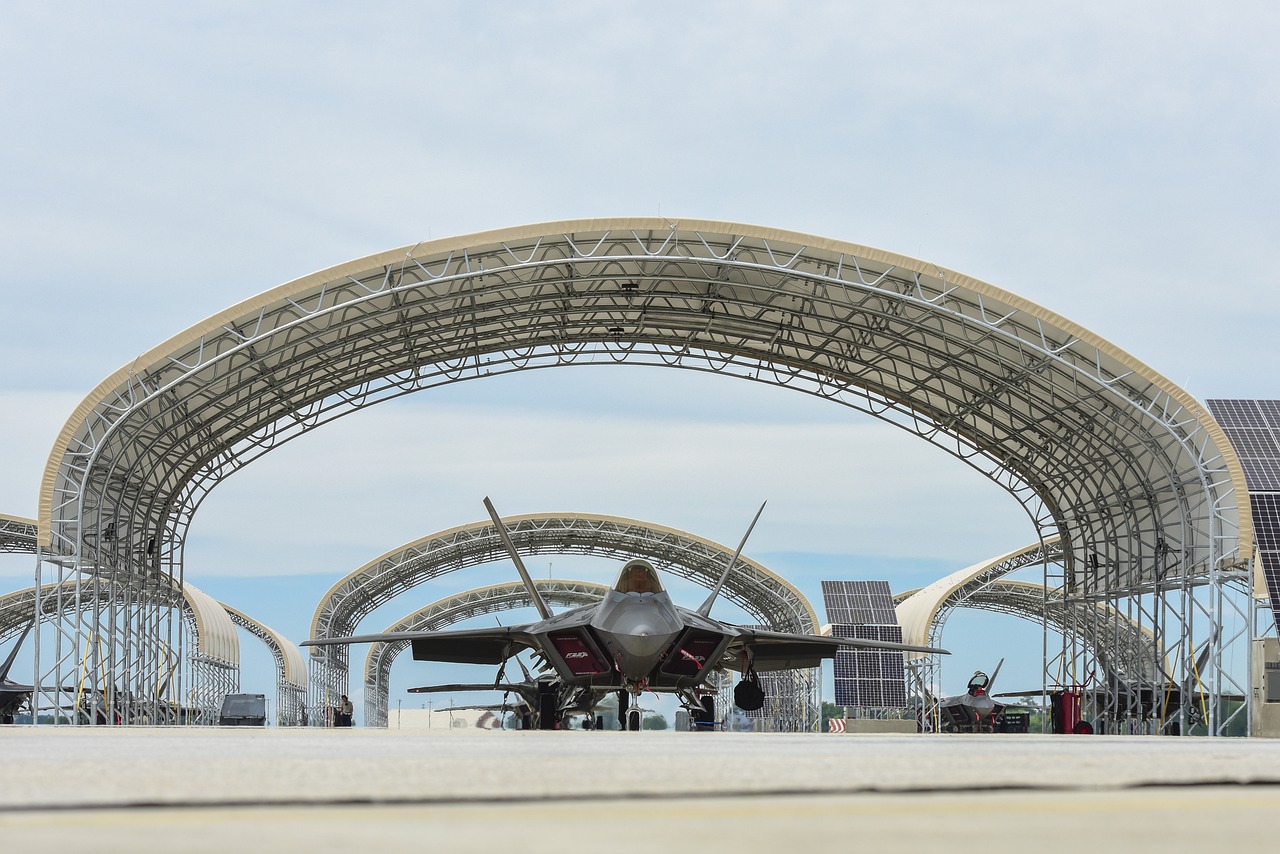
Technological Limitations
This article explores the advancements in stealth technologies that enhance the capabilities of modern combat aircraft, focusing on design, materials, and future implications for military aviation.
Understanding the historical context of stealth technology is crucial for appreciating its current advancements and future potential in combat aircraft design and military strategy.
This section delves into the fundamental principles that guide the design of stealth aircraft, including radar-absorbent materials and shape optimization to minimize detection.
A critical aspect of stealth technology involves reducing an aircraft's radar cross section, which significantly impacts its visibility to enemy radar systems and enhances survivability.
The geometric design of stealth aircraft plays a vital role in deflecting radar waves, and understanding these features helps in grasping how modern fighters achieve stealth.
Innovative materials, such as radar-absorbent coatings, contribute significantly to stealth capabilities, providing a tactical advantage in combat scenarios by minimizing radar signatures.
Managing infrared signatures is essential for stealth aircraft, as it helps reduce their heat emissions, making them less detectable by heat-seeking missiles and other infrared tracking systems.
Despite advancements, developing effective stealth technologies presents challenges, including balancing performance, cost, and operational effectiveness in various combat environments.
Investing in stealth technology often involves complex trade-offs between cost and performance, influencing the design choices made by defense contractors and military planners.
Current technological limitations impact the effectiveness of stealth technologies, necessitating ongoing research and development to address vulnerabilities and enhance operational capabilities. One significant limitation is the complexity of materials used in stealth aircraft. While advancements have been made in radar-absorbent materials, the challenge remains in their durability and maintenance. These materials can degrade over time, especially when exposed to harsh environmental conditions, which can compromise stealth capabilities.
Moreover, the integration of stealth technologies with existing systems poses another challenge. Many legacy systems were not designed with stealth in mind, leading to compatibility issues that can hinder operational effectiveness. This scenario often requires expensive upgrades or complete overhauls, which can strain defense budgets.
Another aspect to consider is the trade-off between stealth and speed. As aircraft designers strive to create faster and more maneuverable jets, they often face the dilemma of sacrificing some stealth features. For instance, the sleek shapes that help reduce radar signatures may not be optimal for high-speed performance, leading to a balancing act that can be difficult to navigate.
Additionally, the development cycle of stealth technologies is lengthy. While initial prototypes can be developed relatively quickly, the process of testing, refining, and deploying these technologies can take years, if not decades. This slow pace can leave military forces vulnerable as adversaries continue to advance their own detection technologies.
In light of these challenges, ongoing research and development are crucial. Defense contractors and military strategists must collaborate closely to explore innovative solutions that can overcome these limitations, ensuring that stealth technologies remain effective in the face of evolving threats.
Looking ahead, the future of stealth technology in combat aircraft will likely involve integration with advanced systems, artificial intelligence, and evolving military tactics to maintain air superiority.
The integration of stealth technologies with unmanned aerial vehicles (UAVs) presents new opportunities for reconnaissance and strike missions, enhancing operational flexibility and reducing risk to human pilots.
Emerging artificial intelligence applications will play a pivotal role in optimizing stealth operations, enabling real-time decision-making and improving the effectiveness of stealth aircraft in complex combat scenarios.
- What is stealth technology?
Stealth technology refers to a range of techniques used to make military vehicles, especially aircraft, less detectable by radar, infrared, and other detection methods. - How does stealth technology work?
Stealth technology works by using special materials and geometric designs to absorb or deflect radar waves, as well as by managing infrared signatures to reduce heat emissions. - What are the main challenges in developing stealth technology?
The main challenges include balancing performance with cost, integrating stealth features with existing systems, and addressing the durability of materials used in stealth design. - What is the future of stealth technology?
The future of stealth technology is likely to involve advancements in artificial intelligence, integration with unmanned systems, and continuous innovations to counter evolving detection methods.

Future Trends in Stealth Technology
The landscape of military aviation is evolving rapidly, and with it, the future of stealth technology is becoming increasingly sophisticated. As we look ahead, we can anticipate a fusion of advanced systems, artificial intelligence, and evolving military tactics that will redefine the concept of air superiority. Imagine a world where stealth aircraft not only evade detection but also adapt their strategies in real-time, making them formidable assets in any combat scenario. This is not just a dream; it's the direction in which stealth technology is heading.
One of the most exciting trends is the integration of stealth technologies with unmanned aerial vehicles (UAVs). This integration opens up a realm of possibilities for reconnaissance and strike missions. UAVs equipped with stealth capabilities can operate in hostile environments without putting human pilots at risk. They can gather intelligence, perform surveillance, and carry out precision strikes with minimal chances of detection. This shift not only enhances operational flexibility but also allows military forces to engage in complex missions that were previously deemed too dangerous.
Moreover, the role of artificial intelligence (AI) in stealth technology cannot be overstated. AI applications are set to revolutionize how stealth operations are conducted. For instance, AI can analyze vast amounts of data in real-time, enabling stealth aircraft to make informed decisions during missions. This capability allows for the optimization of flight paths, ensuring that aircraft remain undetected while achieving their objectives. Imagine an aircraft that can autonomously adjust its course based on real-time threat assessments—this is the future of combat aviation.
As we delve deeper into the implications of these advancements, we must consider the collaboration between manned and unmanned systems. The synergy between piloted stealth aircraft and UAVs can create a multi-layered defense strategy. Manned aircraft can take on more complex roles, while UAVs handle the more dangerous aspects of missions. This collaboration not only enhances effectiveness but also minimizes the risk to human life, which is a paramount concern in modern warfare.
Furthermore, the continuous evolution of military tactics will shape how stealth technology is developed and deployed. As adversaries become more adept at countering traditional stealth methods, innovative strategies will emerge. This might include the use of decoys or electronic warfare tactics that can confuse enemy radar systems. The battlefield of the future will require a dynamic approach to stealth, where adaptability and rapid response become key components of success.
In conclusion, the future of stealth technology in combat aircraft is not just about evading detection; it's about creating a comprehensive warfare strategy that leverages cutting-edge technologies. As we embrace these advancements, we must also remain vigilant about the ethical implications and the need for responsible use of such powerful tools. The next generation of stealth aircraft will be more than just flying machines; they will be intelligent systems capable of redefining the rules of engagement in modern combat.
- What is the primary purpose of stealth technology?
Stealth technology is designed to make military aircraft less detectable by radar, infrared, and other detection systems, enhancing their survivability in combat. - How does artificial intelligence enhance stealth operations?
AI can process real-time data to optimize flight paths, assess threats, and make autonomous decisions, improving the effectiveness of stealth missions. - What role do unmanned systems play in future stealth technology?
Unmanned aerial vehicles equipped with stealth capabilities can conduct missions without risking human pilots, providing greater operational flexibility and safety. - What are some challenges facing stealth technology development?
Challenges include balancing performance and cost, addressing technological limitations, and adapting to evolving enemy countermeasures.
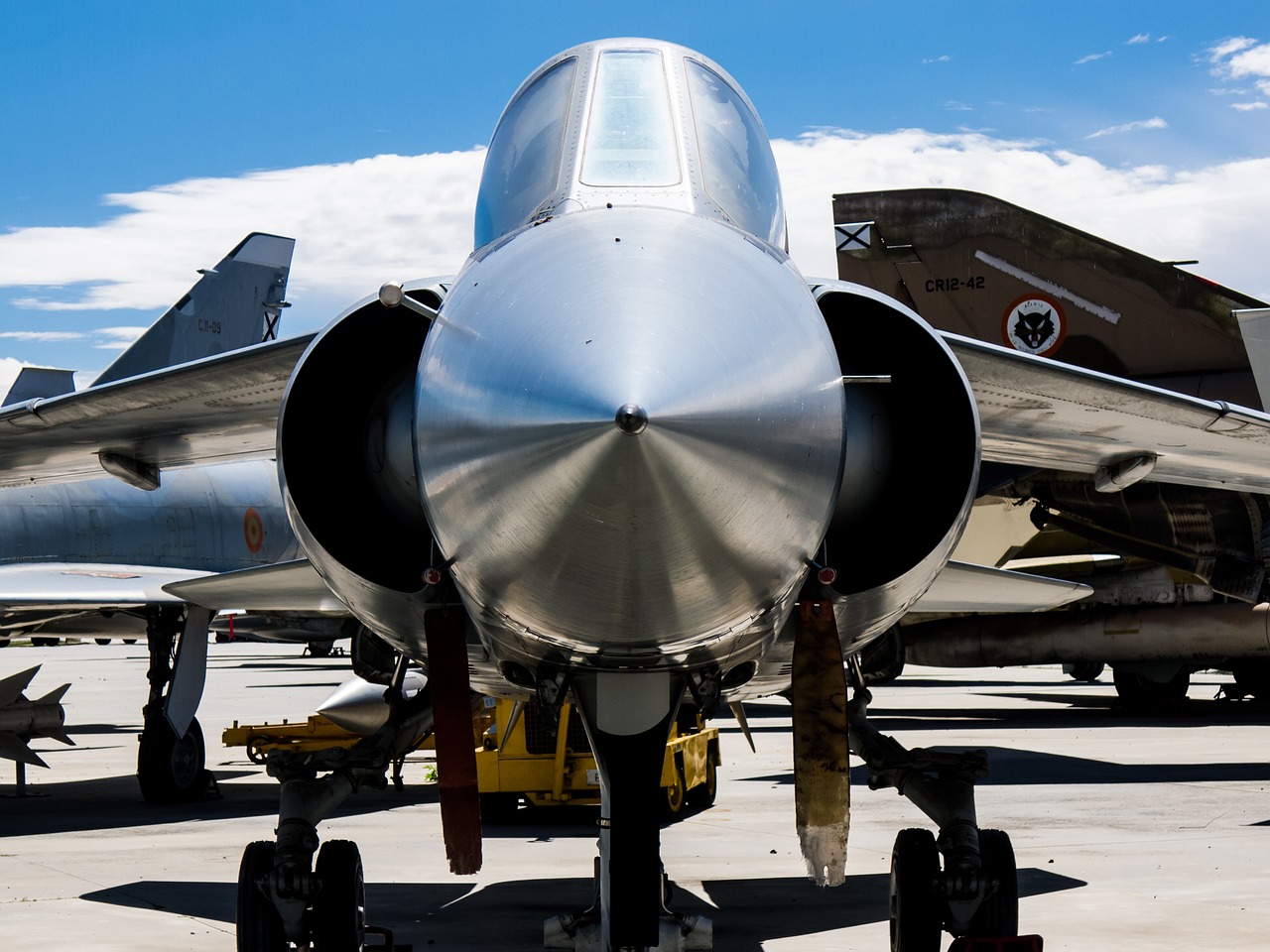
Integration with Unmanned Systems
The integration of stealth technologies with unmanned aerial vehicles (UAVs) marks a revolutionary leap in modern military aviation. Imagine a world where combat missions can be carried out without putting pilots at risk—this is the reality that UAVs bring to the table. By incorporating stealth capabilities into these unmanned systems, military strategists can enhance operational flexibility and effectiveness while minimizing exposure to enemy defenses.
One of the primary advantages of using stealth UAVs is their ability to conduct surveillance and reconnaissance missions in hostile environments. With advanced stealth features, these drones can infiltrate enemy territory undetected, gathering critical intelligence without raising alarms. This capability not only provides a tactical edge but also allows for more informed decision-making in real-time combat scenarios.
Moreover, the integration of stealth technologies with UAVs enables them to perform strike missions with precision. Imagine a scenario where a stealth UAV can launch an attack on a high-value target while remaining invisible to radar systems. This not only increases the likelihood of mission success but also reduces collateral damage, as these drones can be programmed to engage specific targets with pinpoint accuracy.
However, the seamless integration of stealth technologies into UAVs is not without its challenges. The design and engineering of these unmanned systems must ensure that their stealth features do not compromise other essential functionalities, such as payload capacity and flight endurance. Engineers are constantly working to strike a balance between stealth, performance, and versatility. For instance, the incorporation of radar-absorbent materials must be done in a way that does not add excessive weight or complexity to the UAV.
Furthermore, as military tactics evolve, so too must the capabilities of UAVs. The future will likely see the development of swarm technologies, where multiple stealth UAVs operate in unison to overwhelm enemy defenses. This concept is akin to a flock of birds, where individual units can work together to achieve a common goal. By coordinating their movements and sharing data in real-time, these UAVs can create a complex challenge for adversaries, making it difficult for them to target a single unit.
Ultimately, the integration of stealth technologies with unmanned systems is set to redefine the battlefield. As military forces worldwide continue to invest in this area, we can expect to see a new generation of UAVs that not only operate with stealth but also utilize advanced artificial intelligence to enhance their operational capabilities. This convergence of technology will ensure that air superiority remains firmly in the hands of those who can innovate and adapt.
- What are the main advantages of using stealth UAVs?
Stealth UAVs provide enhanced operational flexibility, reduce risk to human pilots, and enable successful reconnaissance and strike missions without detection. - How do stealth technologies enhance UAV performance?
By minimizing radar signatures and infrared emissions, stealth technologies allow UAVs to operate undetected, increasing their effectiveness in hostile environments. - What challenges do engineers face in integrating stealth technologies into UAVs?
Engineers must balance stealth features with performance needs, ensuring that the UAVs remain lightweight and capable of carrying necessary payloads. - What is the future of stealth UAVs in military operations?
The future will likely involve swarm technologies and advanced AI, allowing multiple UAVs to coordinate and operate together for complex missions.

Artificial Intelligence and Stealth
As we stand on the brink of a new era in military aviation, the integration of Artificial Intelligence (AI) into stealth technology is transforming how combat aircraft operate in hostile environments. Imagine a scenario where an aircraft can not only evade enemy detection but also make real-time decisions based on a multitude of data inputs. This is no longer science fiction; it's becoming a reality. AI enhances the capabilities of stealth aircraft by analyzing vast amounts of data to optimize flight paths, predict enemy movements, and adjust tactics on the fly. This means that modern fighters can operate with a level of agility and intelligence that was previously unimaginable.
One of the most exciting aspects of AI in stealth technology is its ability to process information at lightning speed. For instance, during a mission, an AI system can evaluate radar signals, infrared emissions, and even the behavior of enemy forces in real-time. By doing so, it can recommend the best course of action to avoid detection and strike with precision. This level of situational awareness not only enhances the survivability of the aircraft but also increases the likelihood of mission success.
Furthermore, AI can be employed in the design phase of stealth aircraft. Machine learning algorithms can simulate various designs and predict their radar signatures, allowing engineers to optimize shapes and materials before a physical prototype is even built. This approach not only accelerates the design process but also leads to innovations that could significantly reduce an aircraft's radar cross-section.
However, the integration of AI into stealth technology is not without its challenges. There are concerns regarding the reliability of AI systems in critical combat situations. What happens if the AI misinterprets data or makes an incorrect decision? This uncertainty raises questions about the balance between human oversight and automated systems. Military strategists must carefully consider how much autonomy to grant AI in high-stakes scenarios, ensuring that human pilots remain in control while still leveraging the advantages that AI offers.
Moreover, the potential for adversaries to develop countermeasures against AI-driven stealth systems is a real threat. As nations invest in AI technology, the arms race will not only be about stealth but also about the intelligence behind it. This dynamic landscape means that military organizations must continuously adapt and evolve their strategies to maintain an edge in aerial combat.
In conclusion, the marriage of artificial intelligence and stealth technology is paving the way for a new generation of combat aircraft that are smarter, more capable, and harder to detect. As we look to the future, the synergy between these two fields will undoubtedly shape the battlefield, offering unprecedented advantages to those who harness their potential effectively.
- What role does AI play in stealth technology?
AI enhances stealth technology by providing real-time data analysis, optimizing flight paths, and improving decision-making during missions. - Are there risks associated with AI in military applications?
Yes, there are concerns about the reliability of AI systems and the potential for incorrect decisions in critical situations. - How does AI improve the design of stealth aircraft?
AI can simulate various designs and predict their radar signatures, leading to more efficient and innovative aircraft designs. - Will adversaries develop countermeasures against AI-driven stealth?
As AI technology advances, it is likely that adversaries will also develop countermeasures, necessitating continuous adaptation in military strategies.
Frequently Asked Questions
- What is stealth technology?
Stealth technology refers to a set of techniques used to make military aircraft less detectable by radar, infrared, and other detection methods. By minimizing their radar cross section and infrared signatures, these aircraft can operate more effectively in hostile environments without being easily targeted.
- How has stealth technology evolved over the years?
The evolution of stealth technology has been significant since its inception. Initially focused on basic design principles, advancements now include sophisticated materials and geometric shapes that deflect radar waves. This continuous improvement has led to modern aircraft that can evade detection more efficiently than ever before.
- What are the key principles behind stealth aircraft design?
Stealth aircraft design is guided by several key principles, including the use of radar-absorbent materials, optimized shapes that minimize radar reflection, and thermal management to reduce infrared signatures. These principles work together to enhance the survivability of the aircraft in combat.
- What challenges do developers face in creating stealth technologies?
Developers face numerous challenges, including balancing performance with cost, addressing technological limitations, and ensuring operational effectiveness across diverse combat scenarios. These factors can complicate the design and manufacturing processes of stealth aircraft.
- How does artificial intelligence impact stealth technology?
Artificial intelligence plays a crucial role in optimizing stealth operations by enabling real-time decision-making and enhancing the effectiveness of stealth aircraft in complex combat scenarios. AI can analyze data faster and more accurately, allowing for improved tactical responses during missions.
- What is the future of stealth technology in military aviation?
The future of stealth technology is likely to involve greater integration with unmanned systems and advanced AI applications. As military tactics evolve, these technologies will adapt to maintain air superiority and enhance operational flexibility, making them indispensable in modern warfare.
- How do radar-absorbent materials contribute to stealth?
Radar-absorbent materials are designed to absorb radar waves instead of reflecting them. This reduces the radar cross section of an aircraft, making it harder for enemy radar systems to detect and track it. These materials are a key component of modern stealth aircraft design.

